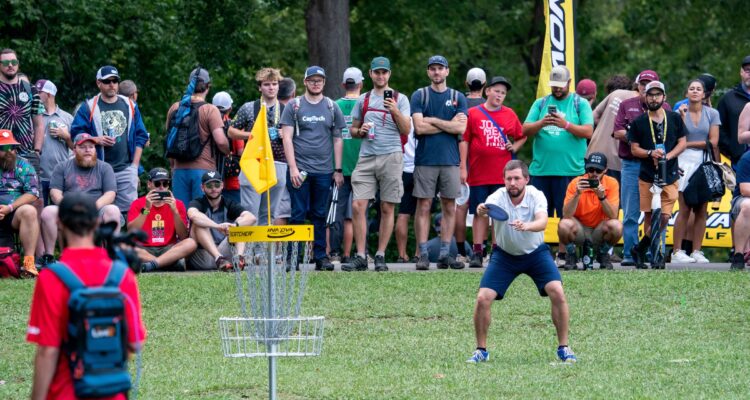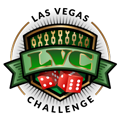Strong mental game separates the Ams from the Pros and the Pros from the elite. Great players are able to quickly push through frustrating moments on the course; the best players use those moments as fuel to help prevent mistakes in the rest of the round. Great players can execute shots despite their nerves; the best players embrace their nerves, recognizing them as a badge of honor only earned by those who put themself in position to succeed. By improving your mental game, you will shoot better on the course and have a more relaxed time while doing it.
This game is way more mental than it is physical.
-Philo Brathwaite
Try to Hit the Gap, Not Miss the Trees
Focus on your landing zone, not on avoiding the water hazard. Focus on hitting the gap, not on missing the trees. When you think about missing obstacles instead of hitting the gap, your eyes end up focused on the obstacle. Nerves creep up, and more often than not you do the exact thing you told yourself not to do. If instead you focus on hitting the gap, your eyes stay locked on your target and your shot is more likely to come out on the desired line. Pick an aim point in the distance that is on your intended line of release. Commit to hitting that point in the sky and forget about the obstacles.
View this post on Instagram
Don’t be Results Oriented
If you hit your gap perfectly, but take an unexpected skip into the rough, don’t beat yourself up over the result. Instead, praise yourself for executing the shot you intended. On the flip side, if you miss your gap entirely, but bounce off of a tree and park the hole, recognize the throwing error, address what went wrong, and then move on to the next tee. Focus on how the shot felt more than where the shot landed. This will keep you from getting frustrated with yourself over good shots that had bad results and will help you learn from your misreleases.
Have a Short Memory
Don’t let bogies beget bogies. Bad shots and bad luck happen. You will take bogies. It is important to put bad shots or bad results behind you and not let them negatively impact the rest of your round. The best players in the sport tend to have the best bounce back percentages (birdie after bogie). Take a deep breath and find some perspective. You are playing disc golf; that bogie probably wasn’t as big a deal as it feels.
Equally important is to not get overly excited by an ace or big throw-in. Staying cool and collected will lead to great throws. If your heart is still racing because of your ace on the previous hole, you are likely to give the stroke right back to the course.
View this post on Instagram
Create Routines
You should have a preround routine, a putting routine, an upshot routine, and a driving routine. Warmup and stretch before you play. Go through your game plan for the course. Drink some water.
Your putting and throwing routines are personal and will vary depending on what works for you. For example, a good putting routine could be as follows: first look for obstacles in your stance. Then step up and mark your lie. Check the wind. Look for low hanging branches that could interfere with your putt. Pick a chain link as an aim point. Set up your footing. Take one practice arm swing making sure to keep all motion in line with the pole. Take a deep breath. Putt on the exhale. This is just one example. The specifics of your routine are much less important than being consistent with whatever routine you choose. Practice putt with the same routine that you use in rounds.
Routines help you execute shots despite being nervous in pressure situations. When you have a 30 footer for the win, if you have a consistent routine each time you putt, you can lean on this routine to help you putt through your nerves. Go through all the same motions as you do in practice and you are likely to make the putt even if you are shaky and nervous. This applies for your upshot and driving routines too.
Embrace Your Nerves
Everyone gets nervous on the disc golf course, especially in high-pressure, tournament situations. Instead of trying to suppress your nerves, reframe the way you think about them. Nate Sexton tells us that nerves are a privilege. They mean you care about what you are doing and have expectations of success. Use your nerves as fuel. If you are on the lead card, your nerves are a badge of pride of the success you have had thus far; the players a few cards back don’t get to experience the nerves of the lead card.
There are tricks to help lessen nerves too. Ken Climo, the winningest player of all time, would only focus on his shots for the 30 seconds between addressing the lie and throwing. Between holes and while his cardmates threw, Climo tried to not think about his round. Instead he talked with players and fans and enjoyed the nature he was surrounded by.
A helpful trick is to take up another hobby that you can do on the disc golf course during your round. Bird-watching or rock-hunting can help prevent the mind from racing during down time between throws. If you still haven’t forgotten about that bogie from three holes ago, or you have a big backup on the next hole, switch activities for a while. Even if it is just for 2 minutes while walking to the next tee, this trick can help you stay out of your own head.
Be Objective About Your Shots
Instead of telling yourself that you just threw the worst shot of your life, be honest and analytical. Admit that the throw was released high and pulled to the right. By giving constructive feedback instead of unconstructive criticism, you will learn more from each mistake, and won’t shake your confidence as you go into the rest of the round. Positive and productive self talk is key.
Know Your Game, Know Your Goals
Competitive disc golf is about scoring. Know your capabilities and play the percentages. Often the best rounds of disc golf aren’t the most aggressive. Good decision making means going for high-percentage shots. Lay up the downhill 50 footers and accept the easy par instead of trying to force a low-percentage birdie by making a high-risk shot. If you are playing on a card with someone who throws farther than you, play your own game. Don’t let another player with a different skill set lead you to throw overly ambitious shots.
If the goal for the day is to hit huge putts or get aces, then play aggressively and don’t be hard on yourself if you don’t score your best.
Commit to Your Shot
Each choice you make on the disc golf course requires full commitment. If you are still deciding between two discs during your run up, you are not focused on the shot at hand. If you can’t decide whether to run a putt or lay it up, you’ll end up throwing a half bid that has a low probability of going in but a high probability of leaving you with a come-backer. Weigh all your options, but be decisive. Often there are multiple equally good options for the shot at hand, making committing to your choice more important than which choice you make.







